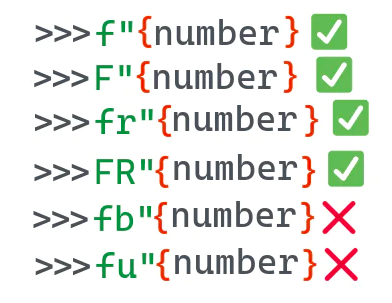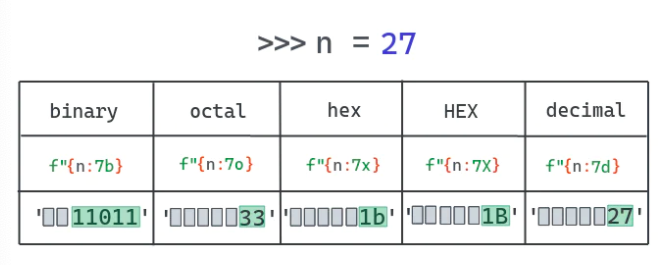标签:__ string format color self 用法 num 73
原文:https://jishuin.proginn.com/p/763bfbd32655
在本文中,我将向你展示我认为对 Python 格式化字符串 f-string 来说最重要的一些技巧。你会通过各种样例学到多种格式化字符串的方法。总的来说,就是你会看到73个关于如何完美应用 f-string 的例子。
目录一览
1. f-string 是什么?
2. 用 python 做基本的文本格式化
3. f-string 局限性
4. 如何格式化表达式
5. 如何使用f-string调试你的代码
6. 如何在不同进制下格式化数字
7. 如何使用格式化字符串常量打印出对象
8. 如何在格式化字符串常量中设置浮点数精度
9. 如何将数字格式化为百分比
10. 如何调整或者增加f-string的填充
11. 如何转义字符
12. 如何使字符串居中
13. 如何添加千位分隔符
13.1如何使用逗号作为千分位分隔符格式化数字
13.2如何使用逗号作为小数分隔符格式化数字
14.如何用科学计数法(指数计数法)格式化数字
15.在 f-string 中使用 if-else
16.如何在 f-string 中使用字典
17.如何用 f-string 拼接字符串
18.如何格式化 datetime 对象
19.如何改正 f-string 的无效语法错误
20.如何在字符串前补零
21.如何编写多行格式化字符串常量(怎样应对新行符号)
22.总结
1、python 中的 f-string 是什么?
在 Python 的历史中,字符串格式化的发展源远流长。在 python 2.6 之前,想要格式化一个字符串,你只能使用 % 这个占位符,或者string.Template 模块。不久之后,出现了更灵活更靠谱的字符串格式化方式: str.format 方法。
过去使用 % 做字符串格式化方式的代码样例:
>>> msg = 'hello world'>>> 'msg: %s' % msg'msg: hello world'
用string.format的样例:
>>> msg = 'hello world'>>> 'msg: {}'.format(msg)'msg: hello world'
为了进一步简化格式化方法,Eric Smith 在2015年提交了 PEP 498 -- Literal String Interpolation 提案。
PEP 498 提出了一种新的字符串插值方法,该方法可以更简单便捷的使用 str.format 方法。你只需要在字符串开头加上一个字母 f,形成 f”” 的格式就可以了。
使用f-string的样例:
>>> msg = 'hello world'>>> f'msg: {msg}''msg: hello world'
这就可以了!再也不需要用 string.format 或者 % 了。不过 f-string 并不能完全替代 str.format。本文也将列举出这两者并不通用的情况。
2、基本的字符串格式化
如上文所述,使用f-string格式化字符串十分简单。唯一的要求就是给它一个有效的表达式。f-string 也可以用大写F开头或者与 r 原始字符串结合使用。但是你不能将其与 b”” 或者 ”u” 混用。

>>> book = "The dog guide">>> num_pages = 124>>> f"The book {book} has{num_pages} pages"'The book The dog guide has 124 pages'>>> F"The book {book} has{num_pages} pages"'The book The dog guide has 124 pages'>>> print(Fr"The book {book} has{num_pages} pages\n")The book The dog guide has 124 pages\n>>> print(FR"The book {book} has{num_pages} pages\n")The book The dog guide has 124 pages\n>>> print(f"The book {book} has{num_pages} pages\n")The book The dog guide has 124 pages
差不多就这些!下一节中,我会用一些例子向你展示一些你用f-string能做或不能做的事儿。
3、f-string 的限制
虽然f-string十分的便捷,但它并不能完全代替str.format。f-string在表达式出现的上下文中进行求值计算。根据PEP498,这意味着该表达式可以获取所有局部和全局变量。而且该表达式是在运行时计算的表达式。如果在 { } 之中使用的表达式无法被计算,就会跳出如下异常。
>>> f"{name}"---------------------------------------------------------------------------NameError Traceback(most recent call last)<ipython-input-1in<module>----> 1 f"{name}"NameError: name 'name' is not defined
这对 str.format 来说就不是问题,你可以提前定义一个模板字符串,并在之后调用.format方法时再传递上下文信息。
>>> s = "{name}">>> s.format(name="Python")'Python'>>> print(s){name}
另外还有个限制是,你不能在f-string中使用行内注释。
>>> f"My name is {name #name}!"File "", line 1f"My name is {name #name}!"^SyntaxError: f-string expression part cannot include '#'
4、如何格式化一个表达式
如果不想定义变量,那你可以在大括号中使用常量。Python会计算该表达式并显示最终计算结果。
>>> f"4 * 4 is {4 * 4}"'4 * 4 is 16'
或者你可以...
>>> n = 4>>> f"4 * 4 is {n * n}"'4 * 4 is 16'
5、如何使用 f-string 来调试代码
调试是f-string最常见的用途之一了。Python3.8 之前,很多人会用一种非常繁杂的hello = 42; f"hello = {hello}”来进行调试。针对此Python3.8引入了一个新功能。你可以用 f"{hello=}" 重写上面的代码,而python会显示hello=42。下面这个例子展示了在使用函数表达式时如何应用该特性,其原理与上文代码是一样的。
>>> def magic_number():...: return 42...:>>> f"{magic_number() = }"'magic_number() = 42'
6、如何格式化数字的不同进制

f-string 还能在不同进制下显示数字。例如,你不需要通过b来对一个int进行格式转化就可以显示其二进制结果。
>>> f'{7:b}''111'
总结一下就是你可以用f-string来格式化:
• int 到二进制
• int 到十六进制
• int 到八进制
• int 到十六进制(所有符号大写)
下面的例子使用缩进功能和进制格式化创建了一个表,可以显示数字在不同进制下的值。
>>> bases = {"b": "bin","o": "oct","x": "hex","X": "HEX","d": "decimal"}>>> for n in range(1, 21):...: for base, desc in bases.items():...: print(f"{n:5{base}}", end=' ')...: print()1 1 1 1 110 2 2 2 211 3 3 3 3100 4 4 4 4101 5 5 5 5110 6 6 6 6111 7 7 7 71000 10 8 8 81001 11 9 9 91010 12 a A 101011 13 b B 111100 14 c C 121101 15 d D 131110 16 e E 141111 17 f F 1510000 20 10 10 1610001 21 11 11 1710010 22 12 12 1810011 23 13 13 1910100 24 14 14 20
7、如何用 f-string 打印对象
你可以用f-string打印自定义对象。默认设置是,如果你向f-string表达式传递了一个对象,它将会显示该对象 __str__ 方法的返回值。不过,你也可以用显式转换操作标志来打印__repr__的值。
-
!r - 使用 repr() 将值转化为文本.
-
!s - 使用 str() 将值转化为文本.
>>> class Color:def __init__(self, r: float = 255, g: float = 255, b: float = 255):self.r = rself.g = gself.b = bdef __str__(self) -> str:return "A RGB color"def __repr__(self) -> str:return f"Color(r={self.r}, g={self.g}, b={self.b})">>> c = Color(r=123, g=32, b=255)# 如不加任何操作符, 会打印 __str__ 的值>>> f"{c}"'A RGB color'# 用`obj!r` 的话会打印 __repr__ 的值>>> f"{c!r}"'Color(r=123, g=32, b=255)'# 使用!s跟默认值一样>>> f"{c!s}"'A RGB color'
Python也允许通过定义不同类型使用__format__方法控制格式化结果,下面的例子会展示所有可能情况。
>>> class Color:def __init__(self, r: float = 255, g: float = 255, b: float = 255):self.r = rself.g = gself.b = bdef __str__(self) -> str:return "A RGB color"def __repr__(self) -> str:return f"Color(r={self.r}, g={self.g}, b={self.b})">>> c = Color(r=123, g=32, b=255)# When no option is passed, the __str__ result is printed>>> f"{c}"'A RGB color'# When `obj!r` is used, the __repr__ output is printed>>> f"{c!r}"'Color(r=123, g=32, b=255)'# Same as the default>>> f"{c!s}"'A RGB color'Python also allows us to control the formatting on a per-type basis through the __format__ method. The following example shows how you can do all of that.>>> class Color:def __init__(self, r: float = 255, g: float = 255, b: float = 255):self.r = rself.g = gself.b = bdef __str__(self) -> str:return "A RGB color"def __repr__(self) -> str:return f"Color(r={self.r}, g={self.g}, b={self.b})"def __format__(self, format_spec: str) -> str:if not format_spec or format_spec == "s":return str(self)if format_spec == "r":return repr(self)if format_spec == "v":return f"Color(r={self.r}, g={self.g}, b={self.b}) - A nice RGB thing."if format_spec == "vv":return (f"Color(r={self.r}, g={self.g}, b={self.b}) "f"- A more verbose nice RGB thing.")if format_spec == "vvv":return (f"Color(r={self.r}, g={self.g}, b={self.b}) "f"- A SUPER verbose nice RGB thing.")raise ValueError(f"Unknown format code '{format_spec}' " "for object of type 'Color'")>>> c = Color(r=123, g=32, b=255)>>> f'{c:v}''Color(r=123, g=32, b=255) - A nice RGB thing.'>>> f'{c:vv}''Color(r=123, g=32, b=255) - A more verbose nice RGB thing.'>>> f'{c:vvv}''Color(r=123, g=32, b=255) - A SUPER verbose nice RGB thing.'>>> f'{c}''A RGB color'>>> f'{c:s}''A RGB color'>>> f'{c:r}''Color(r=123, g=32, b=255)'>>> f'{c:j}'---------------------------------------------------------------------------ValueError Traceback (most recent call last)<ipython-input-201c0ee8dd74be> in <module>----> 1 f'{c:j}'<ipython-input-15985c4992e957> in __format__(self, format_spec)29 f"- A SUPER verbose nice RGB thing."30 )---> 31 raise ValueError(32 f"Unknown format code '{format_spec}' " "for object of type 'Color'"33 )ValueError: Unknown format code 'j' for object of type 'Color'
最后,还有个用来转义ASCII字符的a操作符。更多信息可参考:
docs.python.org/3/library/functions.html#as..
>>> utf_str = "Áeiöu">>> f"{utf_str!a}""'\\xc1ei\\xf6u'"
8、如何用f-string设定浮点数精度
F-string可以像str.format那样格式化浮点数。想要实现这一点,你需要加一个 :(冒号)再加一个 .(英文句号)然后跟着小数点位数最后以f结尾。
举例来说,你可以通过如下代码打印一个浮点数精确到百分位的近似值。
>>> num =4.123956>>> f"num rounded to 2 decimalpalces = {num:.2f}"'num rounded to 2 decimal palces = 4.12’
不加任何选项的话,则会打印浮点数本身的精确值。
>>> print(f'{num}')4.123956
9、如何将一个数字格式化为百分数
Python f-string方法有个非常便捷的实现格式化百分数的操作方法。方法与浮点数格式化类似,但是要用%代替结尾的f。它会将原始数值乘以100并显示成有百分符号的固定格式。精度一样也是可以设定的。
>>> total = 87>>> true_pos = 34>>> perc = true_pos / total>>> perc0.39080459770114945>>> f"Percentage of true positive: {perc:%}"'Percentage of true positive: 39.080460%'>>> f"Percentage of true positive: {perc:.2%}"'Percentage of true positive: 39.08%'
10、如何调整或者增加 f-string 的填充
你可以便捷的通过 < 或者 > 符号来调整字符串填充。

>>> greetings = "hello">>> f"She says {greetings:>10}"'She says hello'# Pad 10 char to the right>>> f"{greetings:>10}"' hello'>>> f"{greetings:<10}"'hello '# You can omit the < for left padding>>> f"{greetings:10}"'hello '

>>> a = "1">>> b = "21">>> c = "321">>> d = "4321">>> print("\n".join((f"{a:>10}", f"{b:>10}", f"{c:>10}", f"{d:>10}")))1213214321
11、如何转义符号
如果你想想打印由大括号括起来的变量名称,而不是该变量的值,那你需要双层大括号 {{}}。
>>> hello = "world">>>f"{{hello}} = {hello}"'{hello} = world'
而如果你想转义双引号,就需要在引号前用反斜线 \ 做标记。
>>>f"{hello} = \"hello\""'world = "hello"'
12、如何使字符串居中

想要实现字符串居中,可以通过 var:^N 的方式。其中var是你想要打印的变量,N是字符串长度。如果N小于var的长度,会打印全部字符串。
>>> hello = "world">>>f"{hello:^11}"' world '>>>f"{hello:*^11}"'***world***'# Extra padding is added to the right>>>f"{hello:*^10}"'**world***'# N shorter than len(hello)>>>f"{hello:^2}"'world'
13、如何格式化千分位

F-string也允许我们自定义数字显示的格式。有个非常普遍的需求就是把数字以每3位为一个间隔使用下划线进行分隔。
>>> big_num = 1234567890>>> f"{big_num:_}"'1_234_567_890'
13.1 如何使用逗号千分位分隔符数字
实际上,你可以随便用任何符号做千分位分隔符。所以用逗号做分隔符也完全没问题。
>>> big_num = 1234567890>>> f"{big_num:,}"'1,234,567,890'
甚至可以一次性同时搞定既有千分位分隔符又有精度设定的浮点数。
>>> num =2343552.6516251625>>> f"{num:,.3f}"‘2,343,552.652'
13.2 如何用空格做千分位分隔符
用空格也可以吗?
好吧,这个问题是挺棘手,不过也能实现。你可以用逗号做分隔符之后再用空格替换逗号。
>>> big_num = 1234567890>>> f"{big_num:,}".replace(',',' ')'1 234 567 890'
还有个方法是设定你的本地语言环境,换成一个用空格作千位分隔符的环境比如pl_PL(波兰语环境)。更多信息可参考这个Stack Overflow链接:
https://stackoverflow.com/a/17484665
14、如何用科学计数法(指数计数法)显示一个数字
可以用 e 或者 E 字符来格式化。
>>> num =2343552.6516251625>>>f"{num:e}"'2.343553e+06'>>> f"{num:E}"'2.343553E+06'>>> f"{num:.2e}"'2.34e+06'>>> f"{num:.4E}"'2.3436E+06'
15、在 f-string 中使用 if-else
F-string也能计算稍微复杂的运算式,比如if/else
>>> a = "this is a">>> b = "this is b">>> f"{a if 10 > 5 else b}"'this is a'>>> f"{a if 10 < 5 else b}"'this is b'
16、如何在 f-string 中使用字典
你可以在f-string中使用字典。唯一的要求是引起整个字符串的引号要跟内部的引号不一样。
>>>color = {"R": 123, "G": 145, "B": 255}>>> f"{color['R']}"'123'>>> f'{color["R"]}'‘’123'此处有误啊应该是‘123’吧>>> f"RGB = ({color['R']},{color['G']}, {color['B']})"'RGB = (123, 145, 255)’
17、如何用 f-string 拼接字符串
合并f-string与普通字符串拼接一样,可以隐式的直接拼接,或者显式地用加号 +,或者使用 str.join 方法。
# 隐式字符串拼接>>> f"{123}" " = "f"{100}" " + " f"{20}" " + "f"{3}"'123 = 100 + 20 + 3'# 使用加号 + 的显式字符串拼接>>> f"{12}" + " != "+ f"{13}"'12 != 13'# 使用str.join的字符串拼接>>> "".join((f"{13}", f"{45}"))'13 45'>>>"#".join((f"{13}", f"{45}"))'13#45'
18、如何格式化 datetime 对象
F-string也支持datetime对象的格式化。其过程与str.format格式化日期的方法很近似。请查阅官方文档中的表格获取更多所支持格式的相关信息。

>>> import datetime>>> now = datetime.datetime.now()>>> ten_days_ago = now -datetime.timedelta(days=10)>>> f'{ten_days_ago:%Y-%m-%d %H:%M:%S}''2020-10-13 20:24:17'>>> f'{now:%Y-%m-%d %H:%M:%S}''2020-10-23 20:24:17'
19、如何修复f-string的非法格式错误
如果用的不对,f-string会报格式错误。最常见的错误就是双引号里面套双引号。单引号也会引发相同错误。
>>>color = {"R": 123, "G": 145, "B": 255}>>> f"{color["R"]}"File"", line 1f"{color["R"]}"^SyntaxError: f-string: unmatched '['>>> f'{color['R']}'File"", line 1f'{color['R']}'^SyntaxError: f-string: unmatched '['
还有个常见错误是在旧版本python中用f-string。python3.6才引入了f-string。如果你在之前版本中使用这个方法,解释器会报格式错误 SyntaxError: invalid syntax。
>>> f"this is an old version"File"", line 1f"this is an old version"SyntaxError: invalid syntax
看到这个错误的话,先确定当前使用的python版本。我检查的方法是在python2.7下通过调用sys.version来获取版本号。
>>> import sys;print(sys.version)2.7.18 (default, Apr 202020, 19:27:10)[GCC 8.3.0]
20、如何在字符串前补零
可以用{expr:0len} 这个方法来进行字符串补零。len是最终返回字符串的长度。还可以增加一个正负号标记。在这种情况下,用+则无论数值为正负数都将显示相应正负号。用-则只有当数值为负数时才显示负号,默认设定也是如此。更多信息可参考该链接
https://docs.python.org/3/library/string.html#format-specification-mini-language
>>> num = 42>>> f"{num:05}"'00042'>>> f'{num:+010}''+000000042'>>> f'{num:-010}''0000000042'>>> f"{num:010}"'0000000042'>>> num = -42>>> f'{num:+010}''-000000042'>>> f'{num:010}''-000000042'>>> f'{num:-010}''-000000042'
21、如何处理多行f-string(换行符的处理)
你可以用换行符\n来打印多行文本。
>>> multi_line = (f'R: {color["R"]}\nG: {color["G"]}\nB: {color["B"...: ]}\n')>>> multi_line'R: 123\nG: 145\nB: 255\n'>>> print(multi_line)R: 123G: 145B: 255
还可以用三引号实现多行字符串。这样不单能增加换行符,还能有Tab。
>>> other = f"""R:{color["R"]}...: G:{color["G"]}...: B:{color["B"]}...:""">>> print(other)R: 123G: 145B: 255
用 Tab 的代码样例
>>> other = f'''...:this is an example...:...:^Iof color {color["R"]}...:...: '''>>> other'\nthis is an example\n\n\tof color 123\n \n'>>> print(other)this is an exampleof color123>>>
22、结论
本文就这些!希望大家学到了一些新奇而实用的知识。知道了如何充分利用 f-string 绝对可以让生活变得更美好。
标签:__,string,format,color,self,用法,num,73 来源: https://www.cnblogs.com/liujiacai/p/15614811.html
本站声明: 1. iCode9 技术分享网(下文简称本站)提供的所有内容,仅供技术学习、探讨和分享; 2. 关于本站的所有留言、评论、转载及引用,纯属内容发起人的个人观点,与本站观点和立场无关; 3. 关于本站的所有言论和文字,纯属内容发起人的个人观点,与本站观点和立场无关; 4. 本站文章均是网友提供,不完全保证技术分享内容的完整性、准确性、时效性、风险性和版权归属;如您发现该文章侵犯了您的权益,可联系我们第一时间进行删除; 5. 本站为非盈利性的个人网站,所有内容不会用来进行牟利,也不会利用任何形式的广告来间接获益,纯粹是为了广大技术爱好者提供技术内容和技术思想的分享性交流网站。
